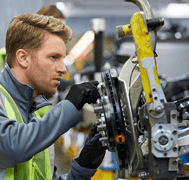 Technology advancements are happening every day.
Technology advancements are happening every day.
While they are exciting, they may also be a bit overwhelming. Particularly, when the economic climate continues to be uncertain.
According to research published by Gartner, 36% of CIOs in the heavy manufacturing segment shared that their companies have experienced some type of disruption which has led to a reduction in operating cost competitiveness.
Technology adoption can seem like an easy fix for this issue. Though, when it comes to technology, more questions pop up:
- Which solution is right for my enterprise?
- Do I take an incremental approach or opt for a complete overhaul?
- How much automation is ‘good’ enough?
Before we answer these questions, we take a look at some of the tech-driven manufacturing solutions that are quite popular today:
I. Lights Out Manufacturing
In the truest sense, lights out manufacturing refers to a fully automated facility where machines do all the work. So, at this type of factory, you won’t need any human intervention apart from routine maintenance or repair.
This may seem like an unrealistic option but companies like FANUC, a Japanese robotics company, have made this a reality. At FANUC, robots literally take care of all aspects of production from assembly and testing to packaging and shipment.
While lights out manufacturing is a futuristic approach, you have to evaluate the associated cost, your need for flexibility, and reliance on human skills before you can consider this option.
II. Mass Customization
Today’s consumer wants personalization.
So, taking a mass customization approach enables you to take the specifications from the customer and pass them directly to the assembly floor – creating differentiated products.
If you are creating fashion apparel, software solutions, or even modular homes, you can truly benefit from mass customization. This approach can help you gain a competitive advantage over other companies in the space.
Though, mass customization does come with added operational as well as supply chain costs. Hence, a careful cost-benefit analysis is needed before opting for it.
III. Additive Manufacturing
As GE puts it, additive manufacturing, also known as 3D printing, is a transformative approach to industrial production. This type of manufacturing can help you deliver lighter, stronger parts and systems.
This approach has made significant strides because it offers flexibility and efficiency. It relies on computer-aided-design (CAD) software and 3D object scanners to direct hardware to create products.
These are just some of the modern approaches to manufacturing.
To think of what works for your business, don’t think of transformation as one big activity. Think of it as smaller steps leading up to something much bigger.
Industry 4.0 technologies are really just a combination of tools – much like an a la carte menu where, as a business, you can choose the things you feel are most impactful for your business.
You can start this journey by reviewing the software you have in place. ERP system solutions, for instance, can help you stay competitive by providing the best value and streamlining your manufacturing processes.
At SHEA Global, we enable you to move beyond this first step by bringing together the ‘right’ tools and creating a strategic transformation plan for achieving operational excellence.
Reach out today to learn how we can support your manufacturing business in its digital transformation journey.